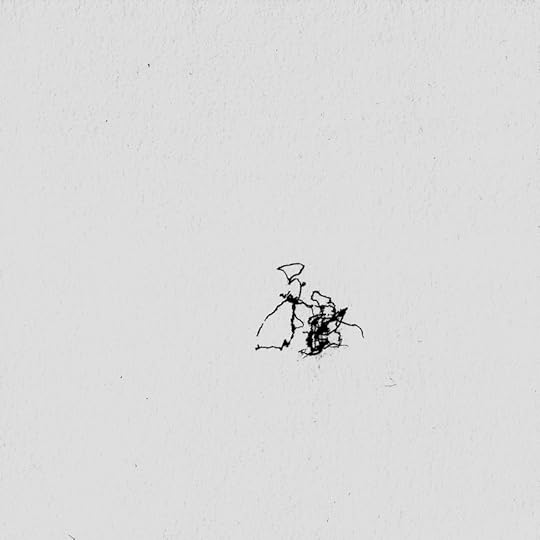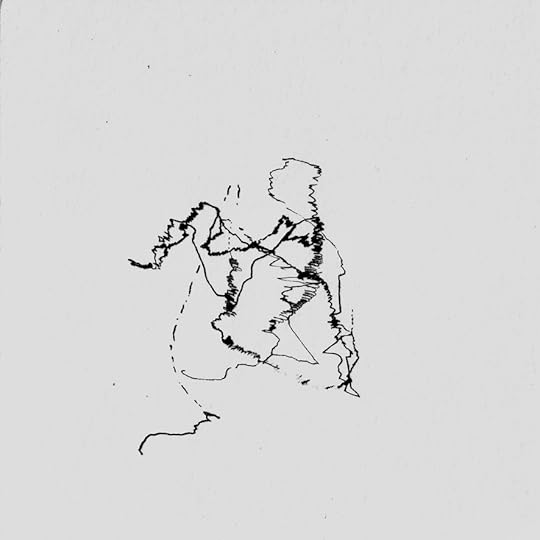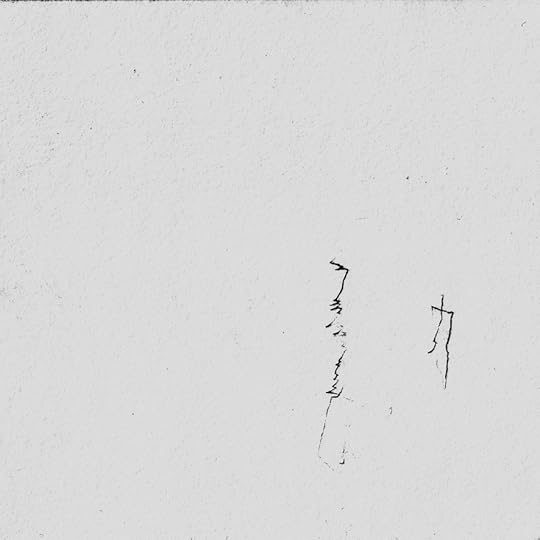drawn to… Music On A Long Thin Wire – Alvin Lucier
Drawn to… Music on a Long Thin Wire by Alvin Lucier is the third in my small series—where I draw to a particular piece of music—hence the ‘drawn to..’ project title. I drew each of the four drawings below blind while listening to a 6 minute 43 seconds excerpt of the album.
 Music on a Long Thin Wire by Alvin Lucier (LP cover)
Music on a Long Thin Wire by Alvin Lucier (LP cover)I used a Marvy Uchida For Drawing 003 black pen on a 10cm X 10cm piece of 250g acid-free clarirefontaine paper. After drawing all four pieces, I scanned them onto photographic paper and glued them onto white card (see below). The total size of this collage is 25 cm X 25 cm (ish).

Music on a Long Thin Wire is an amazing way of creating a piece of ever-changing music. The full liner notes are at the end of this post, but here is how the wire works,
…the wire is extended across a large room, clamped to tables at both ends. The ends of the wire are connected to the loudspeaker terminals of a power amplifier placed under one of the tables. A sine wave oscillator is connected to the amplifier. A magnet straddles the wire at one end. Wooden bridges are inserted under the wire at both ends to which contact microphones are imbedded, routed to a stereo sound system. The microphones pick up the vibrations that the wire imparts to the bridges and are sent through the playback system. By varying the frequency and loudness of the oscillator, a rich variety of slides, frequency shifts, audible beats and other sonic phenomena may be produced... link
It’s a method that has inspired many folk to have a go at creating it themselves.

I may adapt these drawings in the future as each of the four figures suggests something to me, for instance, a Victorian milkmaid walking with her son above and an injured footballer below.

However, I wanted to post the drawings in their raw format first,

which seems to be in keeping with how Lucier himself worked (see his liner notes below).

Alvin Lucier’s liner notes to Music on a Long Thin Wire,
I first got the idea for “Music on a Long Thin Wire” in 1977. Physicist John Trefny and I were teaching a course on musical acoustics at Wesleyan and had set up a modern version of the Pythagorean monochord. We extended a short metal wire across a laboratory table and placed an electromagnet over one end of it. An audio oscillator drove the wire. The interaction between the flux field of the magnet and the frequency and loudness of the oscillator caused the wire to vibrate in ways observable to the naked eye.
I was fascinated by this demonstration and started imagining what a very long monochord-one which could be installed on a concert stage or occupy a gallery space-would sound like. I knew it would sound amazing. I decided to build one. I bought some metal piano wire and sent away to the Edmund Scientific Company for a set of clamps and a horseshoe magnet. After a few weeks of experimentation, I designed a portable instrument whose length could be varied to fit different size spaces.
“Music on a Long Thin Wire” is constructed as follows: the wire is extended across a large room, clamped to tables at both ends. The ends of the wire are connected to the loudspeaker terminals of a power amplifier placed under one of the tables. A sine wave oscillator is connected to the amplifier. A magnet straddles the wire at one end. Wooden bridges are inserted under the wire at both ends to which contact microphones are imbedded, routed to a stereo sound system. The microphones pick up the vibrations that the wire imparts to the bridges and are sent through the playback system. By varying the frequency and loudness of the oscillator, a rich variety of slides, frequency shifts, audible beats and other sonic phenomena may be produced.
I played the wire several times as a solo piece and once as a duet with David Rosenboom in Toronto. When Don Funes asked me to make a work for his Live Electronic Music Ensemble in Potsdam, New York, I invited his players to feed their synthesizer signals into the wire. I was not happy with any of these performances, however; the music never went beyond a kind of poetic improvisation. I finally decided to remove my hand from the musical process. I discovered that by carefully tuning the oscillator, the wire could be left to sound by itself. Fatigue, air currents, heating and cooling, even human proximity could cause the wire to undergo enormous changes. In a dance studio in Kyoto, for example, visitors’ footsteps on the Marley floor caused extremely slight shifts in the positions of the tables to which the wire was clamped, causing spectacular changes in the sound of the wire. Shin Nakagawa, who arranged my visit there, slept overnight under the wire and reported that even with no movement in the room it would mysteriously erupt into triadic harmonies.
Since its conception, “Music on a Long Thin Wire” has been exhibited in numerous spaces. In 1979, it was mounted in the Winrock Shopping Center, Albuquerque, and broadcast on KUNM-FM for five straight days and nights without interruption; in 1980 the wire shimmered three stories above the heads of visitors to the Landmark Center, Saint Paul; and in 1988, it occupied the 90-foot long Gallery of the Center for the Arts at Wesleyan, a graceful space which seemed almost specifically designed for this work.
These recordings were made by the composer on May 10, 1979, in the Rotunda of the U.S. Custom House, Bowling Green, New York City. “Music on a Long Thin Wire” had been installed there as part of the “Custom and Culture” show organized by Creative Time in association with the Custom House Institute, New York Landmarks Conservancy. The wire was extended 80 feet through the oval of the Rotunda.
Four separate recordings were made. For each, a single oscillator tuning was chosen. No alteration of the tuning or manipulation of the wire was made in any way. The wire played itself. All changes in volume, timbre, harmonic structure, rhythmic and cyclic patterning, and other sonic phenomena were brought about solely by the actions of the wire itself.
Alvin Lucier (June 25, 1992)
The post drawn to… Music On A Long Thin Wire – Alvin Lucier appeared first on Graham Holliday.



